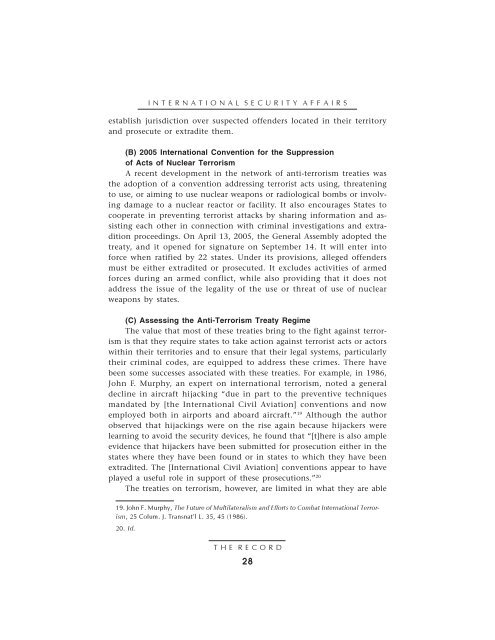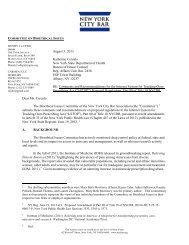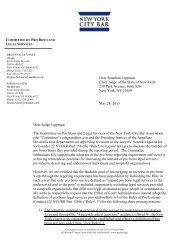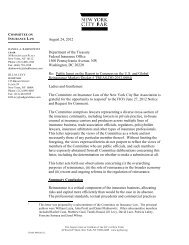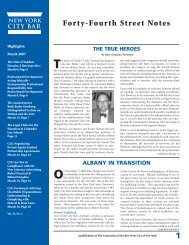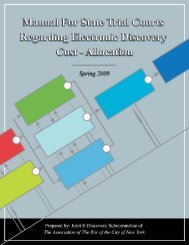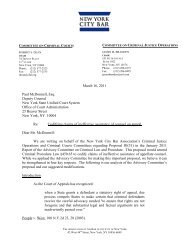2007 Issue 1 - New York City Bar Association
2007 Issue 1 - New York City Bar Association
2007 Issue 1 - New York City Bar Association
Create successful ePaper yourself
Turn your PDF publications into a flip-book with our unique Google optimized e-Paper software.
I N T E R N A T I O N A L S E C U R I T Y A F F A I R S<br />
establish jurisdiction over suspected offenders located in their territory<br />
and prosecute or extradite them.<br />
(B) 2005 International Convention for the Suppression<br />
of Acts of Nuclear Terrorism<br />
A recent development in the network of anti-terrorism treaties was<br />
the adoption of a convention addressing terrorist acts using, threatening<br />
to use, or aiming to use nuclear weapons or radiological bombs or involving<br />
damage to a nuclear reactor or facility. It also encourages States to<br />
cooperate in preventing terrorist attacks by sharing information and assisting<br />
each other in connection with criminal investigations and extradition<br />
proceedings. On April 13, 2005, the General Assembly adopted the<br />
treaty, and it opened for signature on September 14. It will enter into<br />
force when ratified by 22 states. Under its provisions, alleged offenders<br />
must be either extradited or prosecuted. It excludes activities of armed<br />
forces during an armed conflict, while also providing that it does not<br />
address the issue of the legality of the use or threat of use of nuclear<br />
weapons by states.<br />
(C) Assessing the Anti-Terrorism Treaty Regime<br />
The value that most of these treaties bring to the fight against terrorism<br />
is that they require states to take action against terrorist acts or actors<br />
within their territories and to ensure that their legal systems, particularly<br />
their criminal codes, are equipped to address these crimes. There have<br />
been some successes associated with these treaties. For example, in 1986,<br />
John F. Murphy, an expert on international terrorism, noted a general<br />
decline in aircraft hijacking “due in part to the preventive techniques<br />
mandated by [the International Civil Aviation] conventions and now<br />
employed both in airports and aboard aircraft.” 19 Although the author<br />
observed that hijackings were on the rise again because hijackers were<br />
learning to avoid the security devices, he found that “[t]here is also ample<br />
evidence that hijackers have been submitted for prosecution either in the<br />
states where they have been found or in states to which they have been<br />
extradited. The [International Civil Aviation] conventions appear to have<br />
played a useful role in support of these prosecutions.” 20<br />
The treaties on terrorism, however, are limited in what they are able<br />
19. John F. Murphy, The Future of Multilateralism and Efforts to Combat International Terrorism,<br />
25 Colum. J. Transnat’l L. 35, 45 (1986).<br />
20. Id.<br />
T H E R E C O R D<br />
28


